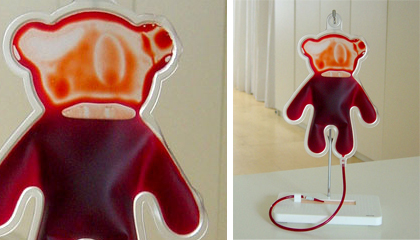Lisa Norton

Lisa Norton
“Everyone designs who devises courses of action aimed at changing existing situations into preferred ones.” Herbert A. Simon
Every human being is always-already a designer but the affordability of 3-D computer prototyping makes that fact more obvious. Over 5 million guns are manufactured each year in the US alone. What’s new is the intersection of the Maker movement, the diffusion of computer-aided rapid prototyping technology, and ingenious tests of Constitutional definitions of defense, liberty, and the right to bear arms.
There is been much debate on the Internet since 2012 over both the instrumental validity aspect – whether a home 3-D printing technology is technically capable of producing a gun that actually fires accurately, as well as the civic dimension of the debate – whether the open source movement can and/or should be regulated. Either way these polemics bring the Modern value of autonomy into tension with the emergent value of communion.

Printable Gun
The range of opportunity made possible by the diffusion of innovation in this arena of ‘self prototyping’ as it sometimes called, has attracted early adopters, extreme users and other hackers who are interested in pushing the innovation envelope. As is true in any frontier, the means are value neutral but the ends are anything but.
Although it’s long been possible (and legal) to make firearms from scratch, the learning curve in engineering and machining and start up costs were steep enough to be achievable only by zealot hobbyists. Home 3-D printers can now be bought for as little as $500. The democratization of computer aided 3-D printing has distributed the power of home designing, amplifying the inscriptive designing agency of the average individual hacker. “The company MakerBot just opened the first retail store dedicated to 3-D printers in Manhattan’s trendy SoHo neighborhood, where it began selling its Replicator 2 desktop printer for $2,199.” (Regalado).
Individual users are testing the edges of this new open-source creative platform in a wide variety of domains including the technical and material affordances of 3-D printing technologies and material capabilities, regulatory control, political freedom, intellectual property protections, digital rights management profit potential, and perhaps most significant, the leveraging of this phenomenon into a useful civic debate around freedom and limits.
On the IP front, Nathan Myhrvold filed for a broad patent for managing “object production rights” through digital rights management (DRM) for 3-D printers.“The patent isn’t limited to 3-D printing, also known as additive manufacturing. It also covers using digital files in extrusion, ejection, stamping, die casting, printing, painting, and tattooing and with materials that include “skin, textiles, edible substances, paper, and silicon printing.” (Regalado).
Cody Wilson, a law student at the University of Texas earned more than 15 minutes of fame when he was invited to debate the limits of open source creativity at the Museum of Modern Art this year, after blogging since 2012 about The Liberator, the 3-D printed gun that he fabricated at home then disseminated in the form of fabrication plans on the Internet. Wilson’s Wiki Weapon was conceived as an open source distribution system for downloading plans for making the weapon at home, a so-called “3-D printable personal defense system.” (Bilton)
Although making accurate and fully functional 3-D printed firearms out of ABS plastic actually remains a significant challenge, the Bureau of Alcohol, Tobacco and Firearms is attempting to predict and control this nonlinear creative trend, typified by sensationalized attempts to evade regulatory systems such as Homeland Security and the need for background checks. Vocal public backlash calling for regulation of the open source movement has added more levels of complexity and lent force to Wilson’s essentially Libertarian point that it is impossible to place regulatory limits on open movements.
Commenting on Dark Wallet, Wilson’s latest innovation which he described as a money-laundering service for Bitcoin, and his forthcoming book, Negative Liberty, technology and design writer Rob Walker writes,“What Cody Wilson has kindly done, with both The Liberator and Dark Wallet, is create a tangible provocation: a thing that is also a lens, pulling the tensions between innovation and existing social structures into sharp focus. When you confront The Liberator or Dark Wallet, you have to also confront the fact that, if you are in favor of a completely free Internet and open source movement, you are, by definition, in favor of its more abhorrent uses: child pornography, gun violence, fraud, and more.” (Twilley)
The political, philosophical and legal challenge of 3-D printed weapons is just the tip of the autonomy iceberg. 3-D printed guns have become the focus largely as a result of being the normative tool of contemporary violence, but this debate points to a much more complex consideration of the inscriptive power of designed everyday human choices and behaviors. Gun violence and the sensationalizing of weapons autonomy are but symptoms of a much deeper biopsychosocial challenge.
At the debate at the Museum of Modern Art, part of MOMA’s Design and Violence project, exploring the ambiguities and contingencies attending open source design, Rob Walker called The Liberator “…an incredibly powerful example of the use of a designed object to force a debate.” (Twilley).
How dangerous is design?
Our designed world has placed our species in danger of extinction, yet paradoxically human innovation and design also represents the greatest flowering of our species’ creative brilliance. As a reflection of the consciousness of human beings, design reflects the spectrum of consciousness from malevolence to beneficence. The values gravity (McIntosh) of a society is mirrored in what we desire and find titillating; what we choose and what we most fear and retaliate against. Our everyday anthro-, ego- and ethnocentric habits make us a threat to our own and to other forms of life. We are in fact, ‘the most dangerous animal of all’ (Smith).
Human designing is our collective, omnipresent, adaptive response to life conditions made tangible in our behaviors, norms, artifacts and traces.
Designed products amplify our anthropocentric values, putting creative and destructive agency into play. As is true of any tool, design may be lent to the service of any value structure. This is the challenge inherent in restorative designing.
“Regulation is a sign of design failure”
William McDunough
Failing Forward
The designed world is shaped by and in turn shapes us. Due to the pervasive nature of design, we tend to discount the reciprocal impact of the built environment upon the nested ecologies of body, mind, psyche, polis and spirit. Designed artifacts, in modeling behavioral and lifestyle norms, teach us how to be human and how to relate to matter and to life. Designed products are thus performative scripts that can serve as mirrors reflective of our consciousness.
“People may dislike the idea of ‘designing’ social systems. Designing social systems may seem mechanistic or authoritarian. However, all social systems have been designed… People have designed the systems within which they live. The shortcomings of those systems result from defective design, just as the shortcomings of a power plant result from erroneous design.” Jay W. Forrester
Innovation is a failing forward (Maxwell). In our failing forward via design, we make and remake reality on a contiguous basis. Consciously and iteratively failing forward we produce possibilities. Oftentimes, this failing forward engages complex feedback loops of malevolent habits and impacts. Such instances are better understood as unconscious design than as design failures. Regardless of intentionality, designed outcomes mutually co-arise within historical contexts themselves conditioned by particular worldviews. Design historian Clive Dilnot has written about the death camps, Auschwitz in particular, in the context of design ethics, “…design did not design the Holocaust. But the planning and design of Auschwitz I and II and the future planning for the city of Auschwitz are as much the work of design as another design project. There is no magical break where one ended in the violence began.” (Dilnot) In this respect death camps can be seen as (horrifically) successful designs in as far as they instantiated the social ideals of the ethnocentric worldview enabled by the design and technological capabilities of Modern global worldview.
Swords into Plowshares
Being wired to fail, we are adapted to testing and iteration as a means to survival.
As humans evolve within complex emergent systems, our failing forward thus conditions and is conditioned by a multivalent semiosphere representing the spectrum of worldviews.
In the messy midst of forces of incremental and paradigmatic change that characterize the evolutionary-involutionary nature of reality, there is a tendency to seize on the latest iteration as the next normal. These attempts at stability tend to result in judgments, schisms and polarization. What are the potential unintended consequences of terraforming Mars? Do free range farming practices represent an incremental failing forward on the way to a humane and ecologically viable food system -or are they merely rebranding neo-barbaric and outmoded practices?
From the evolutionary or adaptive perspective, even seemingly innocuous design is its own kind of danger because it maintains the status quo, unquestioningly reproduces what doesn’t work (sustains our un-sustainability), and follows a well-worn path of imitation rather than risking failure.
Inter-system complexity is always a given in the process of designing. The shift to consciously restorative design thinking has much to do with consciously attending to the multiple systems which daily behaviors relationally touch and impact.
From Homo Faber to Homo Empathicus
Author and developmental social critic Jeremy Rifkin, in his public lecture “The Empathic Civilization”, draws on evolutionary biology, neuro-cognitive science, and developmental theory to explain why we as humans are wired to belong and to empathize. Our mirror neurons physiologically dispose us toward empathic relatedness to humans and other creatures. Rifkin states that this empathic resonance gives us access to our vulnerability and sets us up for human connection. Empathy arises in relation to suffering and in response to human frailty and finitude. Empathy is rooted in the acknowledgment of our mortality and the celebration of our being alive. Although we humans have a predisposition toward empathy, our capacity to act from empathy and to enact compassionate structures is determined by our form of mind.
The heart of Rifkin’s argument is that because consciousness evolves, “to emphasize is to civilize”. He invites us to extend our empathy to the entire human race beyond even global diasporic religious, ethnic, and national ties. By virtue of our trait of empathic sociability, we have the capacity to prepare the groundwork for the empathic civilization of the future.
As designing human beings, how can we begin to “rethink the human narrative” and “prepare the groundwork for an empathic civilization”? (Rifkin).
Rifkin noted that the crisis in Haiti instantly mobilized a global heart consciousness and an outpouring of service, resources, and communitarianism. In the US, whether Columbine, Sandy Hook, or Aurora we instinctively failed forward with human compassion, extending technology in service of loving-kindness. “We have the technology to extend the central nervous system to think viscerally as a (human) family.” (Rifkin).

Teddy Bear Blood Bag
The skillful designer cultivates the ability to suspend the need for certainty in order to consciously play in the polarity of safety and risk. Feeling systems is a leading edge practice toward the re-humanization of our mental geography to account for all dimensions of reality in our designing. It starts with leaning into complexity, attuned to potentials in the present moment. In his insightful book Wired to Care, author Dev Patnaik, describes empathic designing as need-finding. A deep listening that arises from a disposition of curiosity and nonviolence, proceeding without agenda. Svigals Architects won the bid to design and build the new Sandy Hook Elementary School near the site of the former school building, demolished after the massacre. The bid was won largely on the basis of positive community feedback about the radical embrace of the collective grievance process that was woven into the design process itself. The novel process resulted in three proposals, all of which embodied the community’s hope for a more empathically designed future. “Barry and his firm, like no one else, bring human heart and collective inquiry to the mutual design of physical settings with clients.” (Torbert)
Atul Gawande, surgeon and author is an advocate for peak performance oriented healthcare systems redesigned incrementally, on the ground, physician by physician, bringing full humanity and vulnerability to the process of failing forward toward a new kind of empathic medicine where in patients, nurses doctors and staff all have the space to be vulnerably human. “Making systems work is the great task of my generation of physicians and scientists. But I would go further and say that making systems work — whether in healthcare, education, climate change, making a pathway out of poverty — is the great task of our generation as a whole.” (Gawande)
These approaches to restorative designing involve being-with the Other in our full humanity, trusting that the system has everything it needs to move forward, and creating conditions for the elimination of violent products, systems and processes. Designing scripts for restorative human and service narratives that lay the groundwork for a future empathic civilization.
About the Author
Lisa Norton has been Professor at the School of the Art Institute of Chicago since 1992. She teaches, consults and facilitates in whole systems design thinking and re-generative design education. http://www.saic.edu/profiles/faculty/lisanorton/
